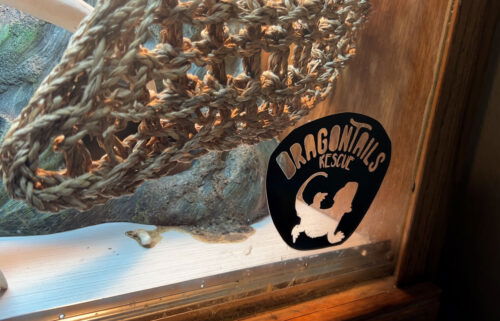Animal shelter populations are up—here's why and how shelters are responding
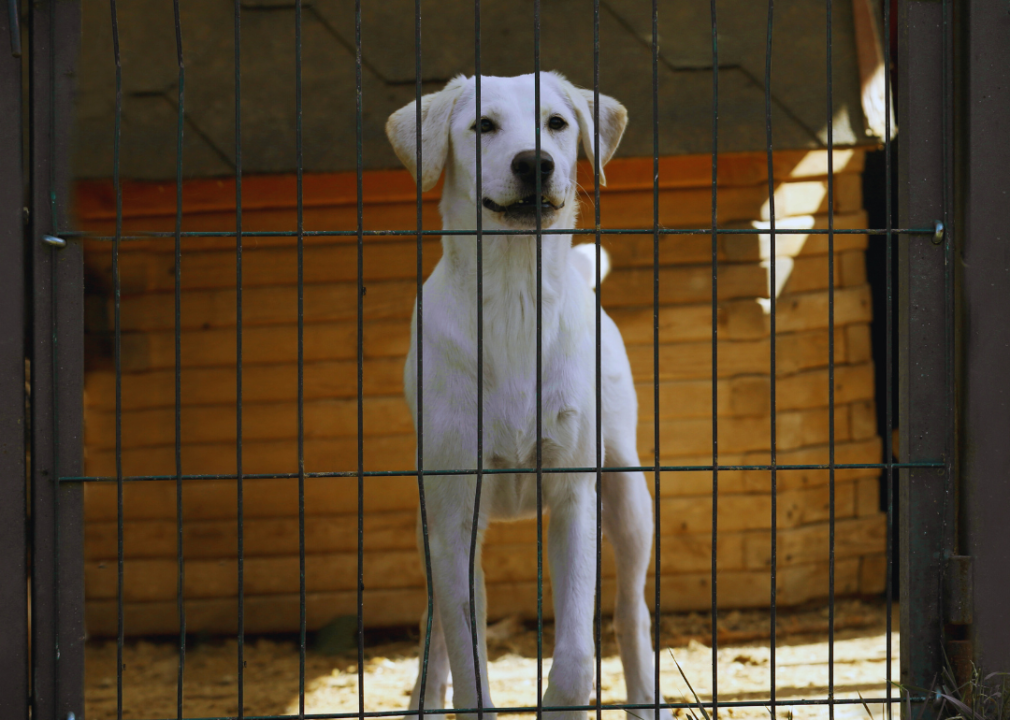
Canva
Animal shelter populations are up—here’s why and how shelters are responding
A tall white dog in a cage in a shelter.
From hosting virtual happy hours to baking bread, people turned to creative ways to resolve their loneliness during the COVID-19 pandemic. One remedy—considered by 1 in 5 American households—was to adopt a pet for companionship.
While that seems like a generous figure, reports from Best Friends Animal Society indicate the number of adoptions has actually dropped since 2019, from 1.26 million to 930,000 every year since 2020 for canines and 1.22 million in 2019 to about 1.10 million every year after for cats. However, pet adoption rates did increase from 2020 to 2022 as COVID-19 policies and logistic issues slowed animal intake at shelters and neutering programs continued, according to veterinary publication dvm360.
Nevertheless, not just humans were affected by social isolation during this time. Many dogs missed out on normal experiences during crucial developmental ages, hindering opportunities to correct behavioral problems early on.
Moreover, canine behavioral issues are more likely to crop up during periods of abrupt change, which is challenging for owners now returning to pre-pandemic work schedules and locations, to say the least. For a dog who has only ever known a remote-working parent, each day they leave is terrifying and confusing—and owners who find themselves with less time to spend with their pets often decide that pet ownership is not for them as a result.
Rising pet care costs are further challenging already cash-strapped families as well. Costs of general goods and services have increased 4% from May 2022 to 2023, and pet expenses have surged at nearly twice the pace, according to the Bureau of Labor Statistics.
Additionally, with more American households renting housing, property managers’ restrictions are spurring many pet and owner separations themselves. According to the Best Friends Network, 13.7% of pet surrenders are due to an inability to secure pet-friendly housing, and shelters nationwide are seeing increases in animal surrenders as a result. In fact, about 1 in 4 intakes in 2023 so far have been due to owner surrender, according to the Shelter Animals Count database.
To further evaluate how animal shelter populations are changing and how shelters are responding, CitizenShipper looked at animal shelter intake data from Best Friends Animal Society.
![]()
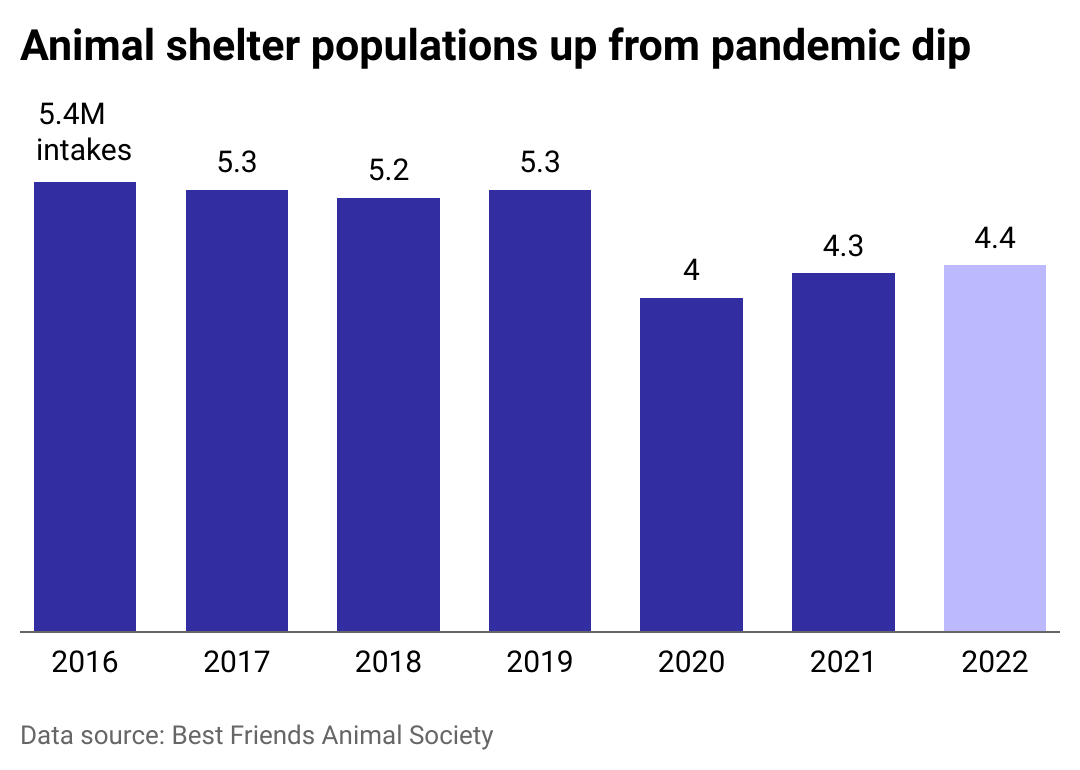
CitizenShipper
Intakes are up, but adoptions aren’t keeping up, causing populations to grow
Column chart showing animal shelter populations up from pandemic dip, reaching 4.4 million in 2022.
According to Best Friends Animal Society, the number of animals taken in by shelters has actually increased every year since 2020, from 4 million to 4.4 million. Most animal surrenders are linked to their owner’s circumstances rather than the behavior or other traits of the animal. For instance, 16.1% of cat and dog shelter surrenders stem from having too many other animals in the household, while 7.2% were compelled to surrender their animal due to financial constraints.
Sadly, dog adoption rates have not rebounded from pandemic lows, thus failing to compensate for the increased amount of intakes. Therefore, shelters with limited capacity must resort to dangerous and ill-advised husbandry practices to limit euthanasia or maintain county and state contracts. In Texas, one shelter in Dallas at 70% over capacity began doubling up large dogs in kennels, and an Austin-based shelter lined its hallways with pop-up crates.
Unfortunately, this strain is not expected to let up any time soon. A Shelter Animals Count report found that animal intakes at shelters will reach a three-year high this year. Best Friends Animal Society further reports that dog adoptions dropped by 26% in 2020, culminating in 170,000 lost canine lives in 2022. The number of lost cat lives declined to 208,000 that same year, saving 10,000 more cats than in 2021. This brings the number of euthanized shelter dogs closer to cats than ever before.
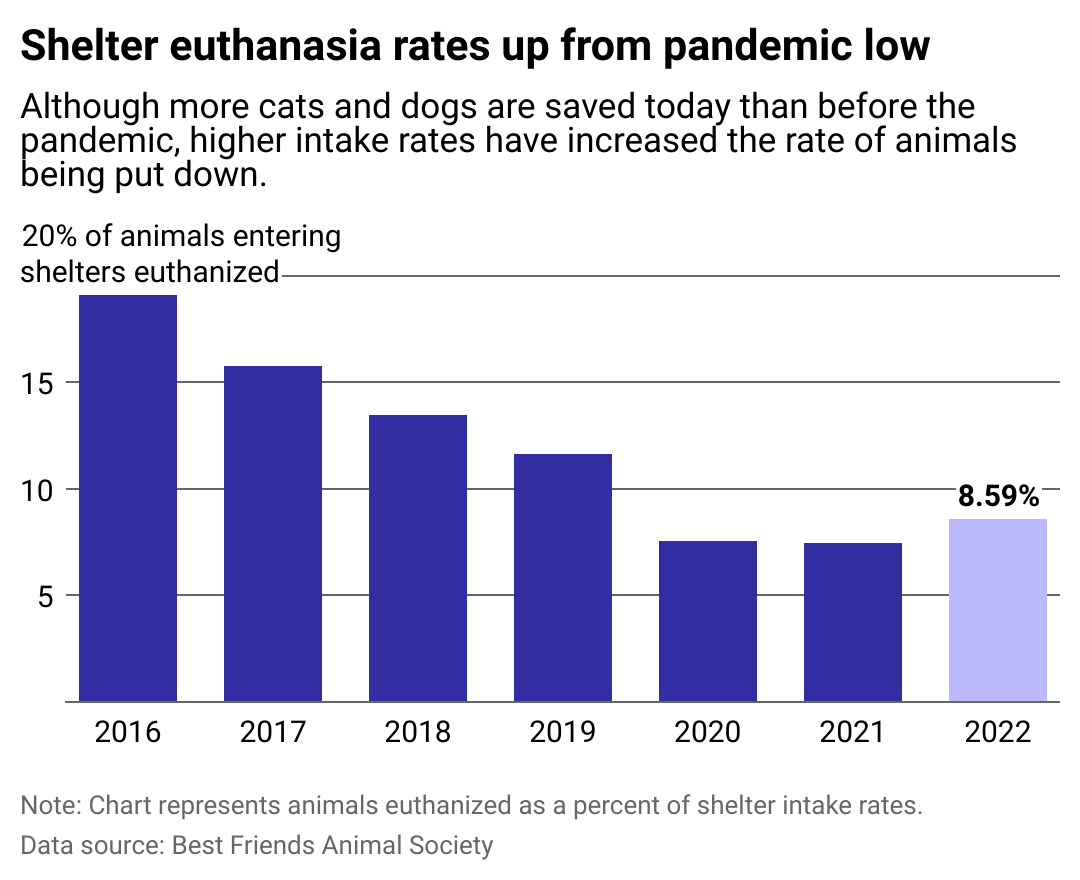
CitizenShipper
More shelter animals are being put down as a result
Column chart showing shelter euthanasia rates up from pandemic low. Although more cats and dogs are saved today than before the pandemic, higher intake rates have increased the rate of animals being put down, reaching 8.6% of all intakes in 2022.
Those 208,000 cats and 170,000 dogs represent the “lifesaving gap,” a measure of shelters’ euthanasia and saving rates. Per Best Friends Animal Society, “saving” in this context can refer to the animal being adopted, transferred to another shelter, returned to the owner, or, in the case of some cats, returned outside after being spayed or neutered. Such instances where a cat is returned to the field represent 6.1% of cats and only apply to those that lived successfully on their own before intake.
The increase in the lifesaving gap between 2021 and 2022 was driven exclusively by the increase in shelter dog euthanasia. For canines, the gap increased by 66.5% from 2021. On the other hand, cats experienced a 4.9% decrease in the lifesaving gap, reflecting fewer lives lost and more saved than the year before.
In addition to an increase in pet surrenders overall, dog and cat adoptions remained flat, leading to strains in the shelter system. Adoptions drove 58.9% of live outcomes for cats following shelter intake but just 46.3% for dogs. However, cats (25.1%) were slightly more likely than dogs (22.5%) to be surrendered by their owners and accounted for 55% of pets that lost their lives in shelters.
Typically, animals with significant health issues or advanced age are selected for euthanasia first, as they are less likely to be rehomed. In many cases, it may also be the humane option, depending on the nature of the animal’s condition; however, such instances are limited.
When faced with the heartbreaking decision to euthanize an otherwise healthy animal due to severely strained resources, animals with behavioral issues are usually among the first to be selected. However, the longer animals are kept in shelters, the more likely they are to develop such behavioral problems. Even while shelters work to reduce euthanasia rates, adoption initiatives and outreach are simply no match for pet overpopulation.
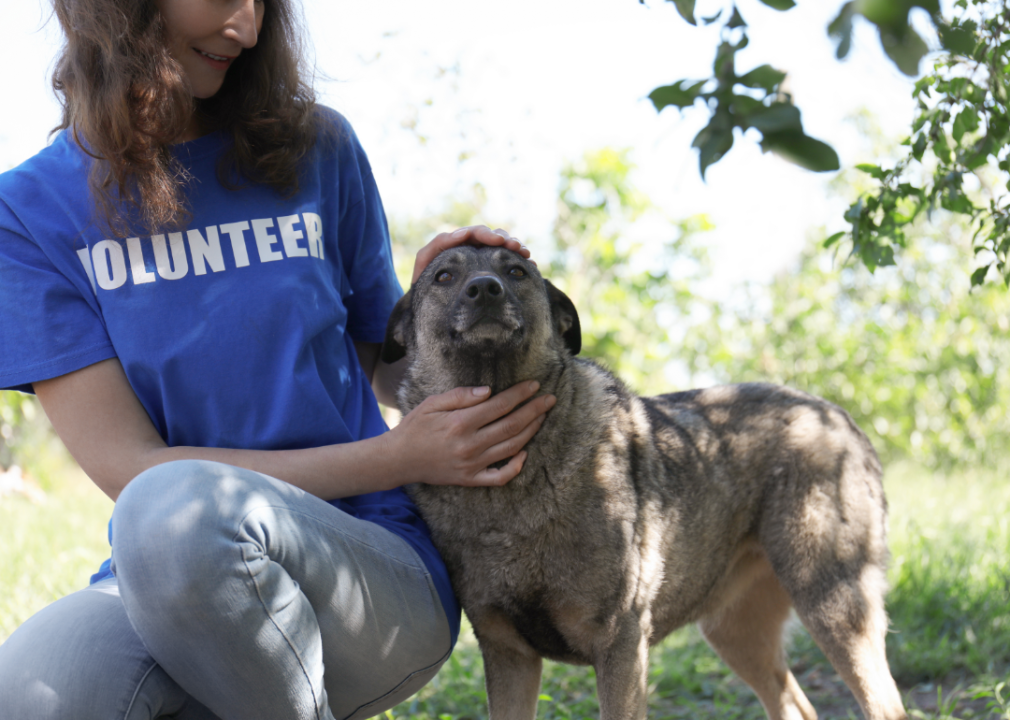
Canva
Animal advocacy groups and shelters are looking for other solutions to help ease the strain
An animal shelter volunteer pets a dog outside in the grass.
While many shelters are at full capacity or beyond, those with vacant kennels are accepting transports to relieve their strain on resources. Such was the actions of the San Diego Humane Society, which transported more than 300 small pets from San Diego to The Humane Society of Southern Arizona in Tucson in August 2023. At the time, the Tucson society had a low inventory of small pets available for adoption.
Shelters are also looking at ways to encourage adoptions, such as adjusting fees or linking clientele with similar resources, like free pet food pantries and affordable spay and neuter clinics.
At the Williamson County Regional Animal Shelter in Texas, animal services director Misty Valenta touts their Best Match program, which puts shelter staff in contact with people looking to adopt one-on-one.
Like a personalized consultation, staff can help prospective adopters choose the animals that best suit their needs; parents and pets can spend time outside together rather than choosing a pet at the shelter; and the shelter also matches pets to potential adopters outside the Williamson County jurisdiction through virtual meetings.
Some organizations are trying unconventional methods to prevent pet relinquishment, even enlisting social workers. At the Denver Animal Shelter in Colorado, for example, a social worker also goes out with community navigators looking for people who may need help, such as the unhoused, seniors, and people with disabilities.
While the social worker addresses issues faced by the vulnerable, the shelter can also offer services geared toward their pets, such as low-cost medical services, supplies, food, and transportation.
As DAS Director Melanie Sobel told CBS News: “Animals are an integral part of the family and both people and their pets benefit when they can stay together. So we meet community members where they are, rather than waiting for them to come to us.”
Story editing by Carren Jao. Copy editing by Paris Close. Photo selection by Ania Antecka.
This story originally appeared on CitizenShipper and was produced and
distributed in partnership with Stacker Studio.




